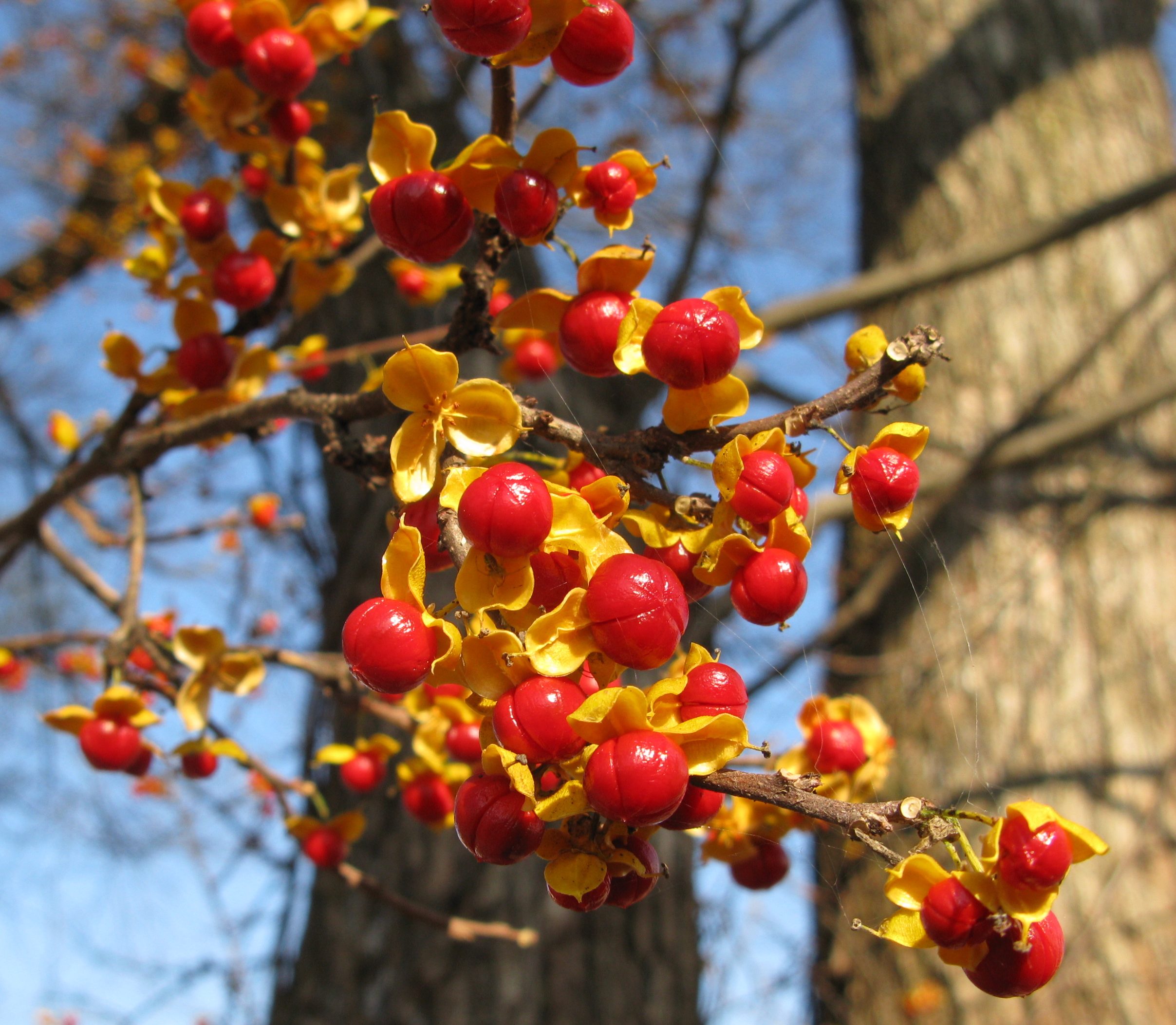
Summary
Oriental bittersweet is an invasive vine that is taking over many of the forests throughout the Northeastern United States. Its fruits are both a source of food for small animals and a commonly used decoration in our homes and gardens. However, Oriental bittersweet is destructive due to its rapid growth and its ability to overtake native vegetation. Luckily, there are things that you can do to combat the spread of Oriental bittersweet.
Bittersweet’s Threat
In some places, Oriental bittersweet is rapidly taking over US forests, smothering any tree and shrub that it comes in contact with. This vine grows vertically, entwining tree trunks and strangling the tree as it grows. Thick mats of bittersweet can grow up as high as 90 feet, making tall trees more susceptible to wind and ice damage. Bittersweet in the forest canopy also captures most of the sunlight and water needed by other vegetation. Thick growths of bittersweet can cover forest floors, smothering saplings and other ground vegetation. The invasive behavior of Oriental bittersweet affects the makeup of forests, harming much of the native vegetation.
Origin & Where It’s Found Today
Oriental bittersweet originated in eastern China, Korea, and Japan, and was introduced to the US in the 1860s as an ornamental plant. In less than 200 years Oriental bittersweet spread from Maine to North Carolina, and as far west as Wisconsin and Missouri. It grows in a variety of habitats from forests to open fields, beaches, marshes, roadsides, and hedgerows. In a 2004 study, bittersweet grew best in areas of high activity (such as along roads) because the forest floor litter (fallen leaves, twigs, dirt, etc.) is not too thick. Bittersweet seeds have thin coats and don’t survive well under thick litter for long periods of time. The researchers concluded that bittersweet grows well in thin litter, such as that found in pine forests or along roadsides. These areas are more prone to bittersweet invasion.

Identification
You can recognize Oriental bittersweet by its spiraling growth up tree trunks. You can also recognize it by its fruits, which grow along vines in groups of 1-3 and are green in summer, turning orange-yellow in late fall. The bright red, fleshy fruit is exposed in the fall when the fruit’s outer skin splits open. Its leaves are glossy, 2-5 inches long, oval-shaped coming to a point, and with fine teeth along the edges. They are green in spring and summer and turn gold in the fall. Mature bittersweet vines are light brown and can be 4 inches thick; young vines are thin, green, and covered in small, lightly colored bumps called lenticels. There is also a native bittersweet species, American bittersweet, that is not as destructive as Oriental bittersweet, but it is difficult to distinguish between the two species. The best way to identify one species from another is to look at their fruit clusters. Look for the stems, which branch off of the vines. Oriental bittersweet’s fruits grow along the length of stems, whereas American bittersweet’s fruits only grow at the end of stems.

How Is It Spread?
The fruits are an attractive food source to animals like birds and small mammals, which have fewer food sources to choose from in the late fall months when bittersweet’s bright red fruits are split open and exposed. Birds eat the fruits, which usually contain 1-2 seeds, and can fly long distances before releasing the seeds. But we play a role in its spread too. Bittersweet is still sold for ornamental purposes. People buy wreaths made of dried bittersweet vines and fruits to hang outside their homes. Seeds can scatter if these decorations aren’t disposed of carefully. Owing to its beautiful, bright red coloration in fall, passersby often pick bittersweet, not realizing they are spreading an invasive plant.

How You Can Help
It is difficult to control bittersweet populations that are already taking over, but there are management techniques you can use if bittersweet has started to invade your yard. Digging up the plant may be successful if you remove as many of the roots as possible and then apply herbicide to the cut ends of the plant. It is best to apply herbicide to bittersweet in the late fall, when other native plants are dormant. If the cut vines are not treated, or roots are left behind, bittersweet is able to regrow quickly. Be careful to remember the differences between American and Oriental bittersweet; American bittersweet does not grow as quickly and does not smother other native vegetation quite like Oriental bittersweet. Make sure not to remove the native, American bittersweet, because that will open up space for Oriental bittersweet to grow in. Although bittersweet has established itself in areas like Crandall Park, removing what vines you can in your yard and foregoing ornamental bittersweet will help to minimize the further spread of this invasive plant.
References
Ellsworth, J.W., Harrington, R.A., & Fownes, J.H. (2004). Seedling emergence, growth, and allocation of Oriental bittersweet: effects of seed input, seed bank, and forest floor litter. Forest Ecology and Management, 190, 255-264.
Finneran, R. (2015). Oriental bittersweet: An aggressive, invasive plant. Retrieved from http://msue.anr.msu.edu/news/oriental_bittersweet_an_aggressive_invasive_plant
Forest Invasive Plants Resource Center (n.d.). Oriental bittersweet. Retrieved from https://www.na.fs.fed.us/spfo/invasiveplants/factsheets/pdf/oriental-bittersweet.pdf
National Park Service (n.d.). Oriental bittersweet. Retrieved from https://www.nps.gov/plants/alien/pubs/midatlantic/ceor.htm
Pavlovic, N.B., Young, S.L., Grundel, R., & Frohnapple, K.J. (2007). American and Oriental Bittersweet identification. Retrieved from https://www.fs.usda.gov/Internet/FSE_DOCUMENTS/fsbdev3_017307.pdf
Image Credits
Oriental bittersweet vine growing around a tree trunk: “Oriental bittersweet” by Landman23 is licensed under CC BY-SA 3.0
Bittersweet berries in fall: “Celastrus orbiculatus” by Qwert1234 is licensed under the Public Domain. Image cropped.
Overgrown bittersweet: “Celastrus orbiculatus” by Leslie J. Mehrhoff, University of Connecticut, Bugwood.org, is licensed under CC BY 3.0
Thick vine growing around a tree trunk: “Oriental Bittersweet five inches thick” by Jay Cross is licensed under CC BY 2.0